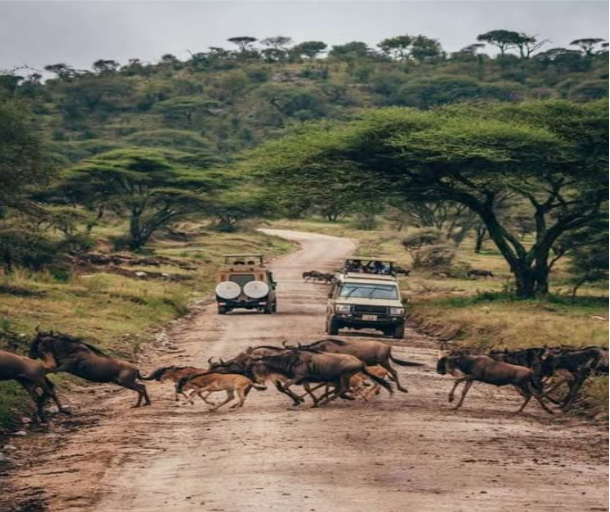Sprawling across 14,750 square kilometers of pristine East African savannah, Serengeti National Park stands as one of Tanzania’s most treasured natural wonders and a beacon of conservation excellence worldwide. This UNESCO World Heritage Site, whose name derives from the Maasai word “Siringet” meaning “endless plains,” has captivated travelers, researchers, and wildlife enthusiasts for generations with its unparalleled biodiversity and spectacular natural phenomena.
A Geographic Marvel in Northern Tanzania
Situated in the northern region of Tanzania, Serengeti National Park borders Kenya’s Maasai Mara National Reserve to the north, while the Ngorongoro Conservation Area flanks its southeastern edge. This strategic location within the Serengeti ecosystem contributes to its ecological significance, as it forms part of the greater Serengeti-Mara ecosystem that spans approximately 30,000 square kilometers.
The landscape of Serengeti National Park in Tanzania showcases remarkable diversity, transitioning from vast grasslands and acacia-dotted plains to woodland areas and rocky outcrops known as kopjes. The park’s variable topography creates distinct ecological zones that support its remarkable biodiversity. The central Seronera Valley, with its year-round water sources, serves as a vital hub for wildlife throughout changing seasons.
Biodiversity Treasure Trove
The Serengeti’s fame largely stems from its extraordinary concentration of wildlife. The park hosts approximately 70 large mammal species and 500 bird species, making it one of Africa’s most biologically diverse protected areas. Visitors to the national park Serengeti Tanzania can expect to encounter the renowned “Big Five” — lions, leopards, elephants, rhinoceros, and buffalo — alongside countless other species including cheetahs, hyenas, giraffes, zebras, and diverse antelope species.
The Serengeti’s lion population, numbering approximately 3,000 individuals, represents one of the largest concentrations of this iconic predator in Africa. Research conducted within the park has significantly contributed to our understanding of lion social behavior and ecology, highlighting the Serengeti’s importance as a living laboratory for conservation science.
The Great Migration: Nature’s Grand Spectacle
Perhaps no natural phenomenon is more closely associated with Serengeti National Park than the Great Migration. This annual movement of over 1.5 million wildebeest, accompanied by hundreds of thousands of zebras and gazelles, constitutes the largest terrestrial mammal migration on Earth. Driven by seasonal rainfall patterns and the resulting changes in grazing conditions, these herbivores traverse the Serengeti-Mara ecosystem in a continuous clockwise circuit.
The migration’s most dramatic moments occur at river crossings, particularly at the Mara River, where crocodiles await the hesitant herds. These crossings represent both the migration’s greatest peril and its most sought-after spectacle for visitors to national park Serengeti Tanzania. The timing of the migration varies annually based on rainfall patterns, but generally, the herds move northward through the central Serengeti between May and July before crossing into Kenya’s Maasai Mara, returning south to calving grounds in the southeastern Serengeti between December and March.
Conservation Challenges and Triumphs
Serengeti National Park’s establishment in 1951 marked a watershed moment in Tanzania’s conservation history. The park has since become a model for protected area management, balancing ecosystem preservation with sustainable tourism and community involvement. However, the Serengeti ecosystem faces numerous contemporary challenges, including habitat fragmentation, human population growth along its boundaries, poaching pressure, and climate change impacts.
Conservation initiatives within Serengeti National Park have achieved notable successes. Anti-poaching efforts have contributed to recovering populations of previously threatened species, including elephants and rhinoceros. Community-based conservation programs engage local communities as stakeholders in the park’s protection, recognizing that sustainable conservation depends on addressing human needs alongside ecological priorities.
Research conducted within the Serengeti has profoundly influenced wildlife management practices globally. Long-term ecological studies, some spanning decades, provide invaluable data on predator-prey dynamics, migration patterns, and ecosystem resilience. This research legacy underscores the park’s significance beyond its boundaries as a living laboratory for conservation science.
Visitor Experience and Sustainable Tourism
For travelers, Serengeti National Park offers an unparalleled safari experience. The park’s infrastructure includes various accommodation options ranging from luxury lodges to tented camps, catering to different preferences and budgets. Game drives remain the primary activity, allowing visitors to witness the park’s wildlife in their natural habitats across different sectors of the park.
Responsible tourism practices are increasingly emphasized within the park, with visitors encouraged to minimize their environmental footprint through water conservation, proper waste management, and adherence to wildlife viewing guidelines. These measures help ensure that tourism supports rather than undermines the park’s conservation objectives.
Optimal visiting periods depend on travelers’ specific interests. While the migration presents spectacular viewing opportunities year-round at different locations within the park, the dry season (June to October) generally offers excellent game viewing as animals concentrate around limited water sources. The wet season (November to May) brings lush landscapes, fewer crowds, and excellent bird watching opportunities.
Future Outlook
The future of Serengeti National Park depends on addressing evolving conservation challenges while maintaining its ecological integrity. Climate change presents perhaps the most significant long-term threat, potentially altering rainfall patterns that drive the migration and ecosystem functions. Conservation strategies increasingly incorporate climate resilience planning alongside traditional protection measures.
Technological innovations, including satellite tracking of migratory herds and remote surveillance systems, enhance management capabilities and research opportunities. These tools, combined with community engagement and sustainable tourism practices, offer pathways for preserving the Serengeti’s natural wonders for future generations.
Conclusion
Serengeti National Park remains Tanzania’s crown jewel of conservation, exemplifying the extraordinary biodiversity of East Africa while facing the complex challenges of modern conservation. The park’s ongoing story—from its establishment as a protected area to its current status as a globally recognized conservation icon—demonstrates both the value of preserving natural systems and the continuous effort required to maintain them.
For visitors fortunate enough to experience its wonders, the Serengeti offers more than spectacular wildlife viewing; it provides a profound connection to natural processes that have shaped our planet for millennia. As conservation efforts continue to evolve, the park stands as testimony to Tanzania’s commitment to preserving its natural heritage and the global importance of protecting our planet’s biodiversity hotspots for generations to come.
